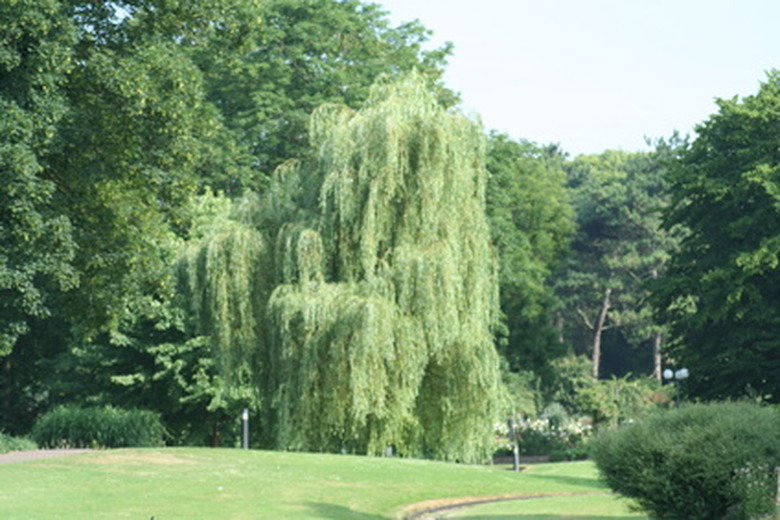Problems With Weeping Willows
The weeping willow tree is part of the Salix genus of plants. The crown of the plant is round, with long branches that hang down towards the ground. Due to its massive root system and large body, the weeping willow requires requires regular pruning to ensure it reaches a mature age of 30 years, says the University of Florida.
Roots
Weeping willows require placement away from residential structures, sewer pipes, septic systems or draining fields. The roots will otherwise interfere with the structures, causing damage. Weeping willow roots are aggressive and spread around three times the size from the trunk of the tree to the tree's canopy edge, says the University of Florida.
Disease
Weeping willow is susceptible to a variety of diseases. Root rot, caused by fungi or the roots' extended exposure to heavy flooding, prevents the tree from absorbing water and nutrients from the ground. Willow scabs or twig blight develops on the midribs of leaves as black or brown spots, says the University of Minnesota, and causes the leaf to drop. Cytospora canker, another common willow disease, causes small sunken areas of flesh along the branches, which, if left untreated, causes the branches to die back.
- The weeping willow tree is part of the Salix genus of plants.
- Cytospora canker, another common willow disease, causes small sunken areas of flesh along the branches, which, if left untreated, causes the branches to die back.
Pests
Weeping willow trees are a host to an array of insects, including scale, caterpillars, borers and aphids. The weeping willow canopy does not attract bird wildlife, leaving these bugs to breed and multiply. Borers can cause the tree to become yellow and lose leaves, says the North Dakota University extension. Aphids, borers, leaf beetle and others can cause limb and leaf death, and eventually the death of the willow, if left untreated.
Willow Trees And Weeping Willow Trees?
More than 100 species of willow grow within North America alone. It grows up to 50 feet tall and 40 feet wide. The tree's branches flow from the "weeping" branches to the ground, providing privacy both behind and directly beneath the tree. Like other members of the willow family, the weeping willow can be invasive in the wild. If the area in which you want to plant a tree or bush can't be kept consistently moist, or if a weeping willow is too large for your property, consider other willows. The bayberry willow (Salix myricoides), which grows up to 20 feet tall, and the prairie willow (Salix humilis), which grows between 2 and 8 feet tall, are both good candidates for sandy and dry conditions — quite the opposite of what weeping willows need. Salix trees and shrubs spread rapidly. In California, for example, no willow trees are currently on the state's Invasive Plant Inventory Database.
- Weeping willow trees are a host to an array of insects, including scale, caterpillars, borers and aphids.
- Aphids, borers, leaf beetle and others can cause limb and leaf death, and eventually the death of the willow, if left untreated.
